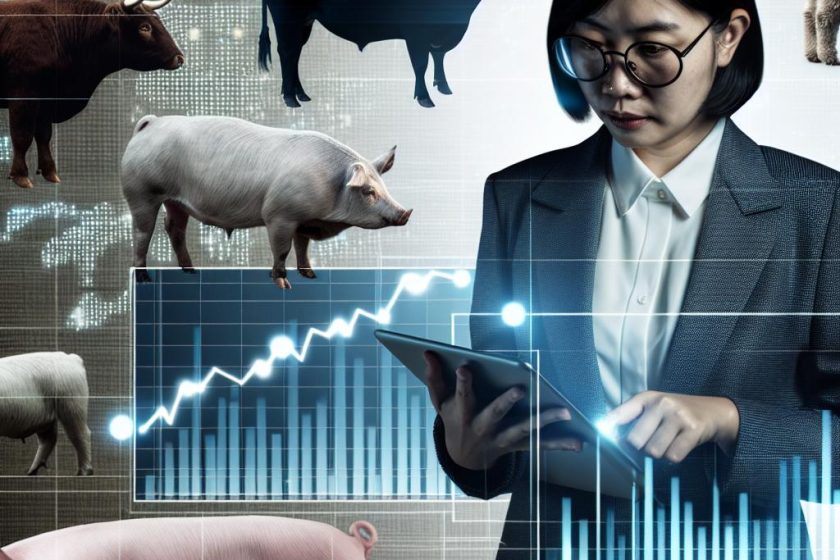The Basics of Livestock Commodity Trading (Cattle, Hogs, etc.)
By : Admin -

The Basics of Livestock Commodity Trading
Engaging in livestock commodity trading involves the buying and selling of commodities such as cattle and hogs. This sector plays a critical role in the global agricultural markets and can be both rewarding and challenging for traders.
Understanding Livestock Commodities
Livestock commodities are primarily categorized into two types—cattle and hogs. These categories are further subdivided into specific markets such as live cattle, feeder cattle, and lean hogs.
Live Cattle: These refer to cattle that are ready to be sold to meat processors. They are typically older than feeder cattle and have reached a marketable weight, reflecting their readiness for processing into beef products. The trading of live cattle is a crucial segment within the livestock commodities market due to the substantial global demand for beef.
Feeder Cattle: Feeder cattle are younger cattle still in the growth phase, continuously fed and nurtured until they reach an appropriate weight to transition into live cattle. Feeder cattle trading is significant because it involves speculating on future beef production. Many factors influence the feeder cattle market, such as feed prices and weather patterns, which can affect cattle’s growth rates and health.
Lean Hogs: Referring to mature hogs intended for processing into pork products, lean hogs represent a major component of the meat industry. Unlike cattle, hogs grow quickly, and thus, their trading cycle is shorter. The price of lean hogs can fluctuate due to various factors, including health concerns like swine flu, which can impact pork industries globally.
Key Factors Influencing Prices
The prices of livestock commodities are subject to various factors, which traders must be keenly aware of to make informed decisions.
Supply and Demand: The balance of supply and demand is perhaps the most significant factor influencing livestock prices. Seasonal changes can affect livestock growth and availability, while consumer demand drives how much meat is required in the market. For instance, holidays and cultural events might increase demand for specific meats, thereby driving price changes.
Weather Conditions: Adverse weather events, such as droughts or floods, can heavily impact the availability and cost of feed, which subsequently influences livestock production and their market prices. Droughts may reduce feed crop harvests, increasing the cost of feeding animals, and might force farmers to sell off livestock prematurely, affecting market prices.
Trade Policies: International trade policies also play a significant role in livestock commodity trading. Tariffs, import/export restrictions, and international trade agreements can have profound impacts on both the movement and pricing of livestock commodities. For example, a trade agreement that limits the export of pork from a major producing country can lead to an oversupply domestically, subsequently reducing prices.
How to Trade in Livestock Commodities
Trading in livestock involves various financial instruments, each designed to serve different purposes and strategies.
Futures Contracts: Futures contracts are standardized agreements to buy or sell a specified amount of livestock at a predetermined price at a future date. These contracts are pivotal for providing liquidity and stability to the market. Farmers and meat processors utilize futures contracts to hedge against price volatility, allowing them to secure prices for their commodities in advance. The use of futures helps dilute the impacts of sudden price shifts due to unforeseen market changes.
Find more information about livestock futures trading here.
Options: Options are financial instruments that provide the buyer the right, but not the obligation, to buy or sell a futures contract at a set price before a certain date. Options serve as a critical risk management tool, allowing traders to protect against unfavorable price movements. For instance, a trader expecting the prices of cattle to rise might purchase a call option to secure the right to buy futures at the current lower price. On the other hand, a put option could protect against price declines.
Market Participation
The livestock commodity markets comprise a diverse array of participants, from individual speculators to large institutional investors and commercial entities. Each participant type plays a crucial role in shaping market dynamics.
Engaging in livestock commodity trading requires a deep understanding of market dynamics, economic principles, and the various external factors that influence supply and demand. For prospective traders, gaining education on these aspects and keeping abreast of fluctuating market conditions is essential. Due to its complex nature, traders often rely on analytical tools and market research to navigate the intricate web of influences that dictate livestock commodity prices.
In conclusion, livestock commodity trading is an essential component of global agricultural markets. By comprehending the fundamental elements of this sector and maintaining a vigilant focus on market conditions, individuals can find rewarding opportunities within this challenging arena. As with any trading practice, a judicious approach, grounded in knowledge and careful analysis, is indispensable for achieving success in livestock trading.
This article was last updated on: June 27, 2025